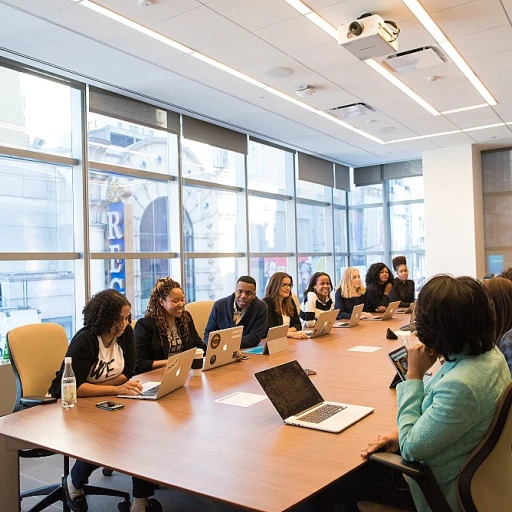Understanding the Importance of Employee Recognition
The Power of Recognition in the Workplace
In today's competitive business environment, understanding the importance of employee recognition is crucial for any company aiming to thrive. Recognizing employees is not just about handing out rewards or gifts; it's about creating a culture where team members feel valued and appreciated for their contributions. This sense of appreciation can significantly enhance the employee experience, leading to increased engagement and productivity.
When employees feel recognized, they are more likely to be motivated and committed to their work. This is because recognition taps into the fundamental human need to feel valued and respected. A well-implemented recognition program can transform the workplace into a more positive and productive environment, fostering a sense of belonging and loyalty among employees.
Why Recognition Matters
Employee recognition is a powerful tool for building a strong workplace culture. It aligns with company values and helps reinforce the behaviors and achievements that contribute to the organization's success. By celebrating achievements and recognizing efforts, companies can create a positive feedback loop that encourages employees to continue performing at their best.
Moreover, recognition can be a low-cost yet highly effective way to boost morale and foster team building. Whether it's through formal recognition programs or informal peer recognition, the act of acknowledging someone's hard work can make a significant difference in how employees feel about their place of work.
For more insights on how to show appreciation to your team, consider exploring thoughtful Thanksgiving gifts for your team as a way to express gratitude and strengthen team bonds.
Traditional vs. Modern Recognition Methods
Embracing New Methods to Appreciate Employees
Employee recognition has evolved considerably over the years. The traditional methods of acknowledging employees in the workplace through plaques or certificates are giving way to more innovative, creative recognition strategies. These modern approaches not only celebrate accomplishments but also enhance the overall employee experience, making people feel truly valued.
One noticeable shift has been the incorporation of more diverse recognition methods. Instead of a one-size-fits-all approach, companies are now offering personalized rewards and recognition systems to better align with company values and employee preferences. It's becoming increasingly important to recognize employees in ways that feel meaningful and personal to them.
Social Media and Peer Recognition
The rise of social media has also introduced new ways to highlight employee achievements. Companies are recognizing employees publicly, boosting both morale and visibility. This peer recognition approach, where team members celebrate each other's achievements, fosters a more supportive and inclusive workplace culture.
Gifts and Low-Cost Appreciation Methods
Gone are the days when a generic 'Employee of the Month' plaque was sufficient. Today, employees feel more appreciated through thoughtful gifts and other unique rewards that resonate personally. Some companies have integrated low-cost recognition programs that focus on giving rewards that are meaningful rather than transactional. These programs aim to make team members feel recognized in genuine ways that contribute to better team building and employee engagement.
As companies continue to innovate in how they recognize and appreciate their employees, the focus remains on creating a culture of recognition...one that acknowledges the hard work and commitment of individuals and teams alike.
Personalized Recognition Strategies
Unique Approaches to Recognizing Individuals
Personalized recognition strategies are at the forefront of transforming how companies appreciate their employees. In today's ever-evolving workplaces, a one-size-fits-all approach to recognizing employees is no longer sufficient to deeply engage team members. Companies are now leaning towards more personalized methods, tailored to individual preferences, to ensure that employees feel truly valued and recognized for their unique contributions.
Investing in personalized recognition can greatly enhance the employee experience, fostering a culture where individuals feel seen and heard. Such efforts can be as simple as acknowledging employee milestones with a personal note or as elaborate as designing a rewards program centered around personal achievements and preferences.
Moreover, incorporating the personal interests of employees into their recognition can make the appreciation more meaningful. For example, offering a gift that aligns with an employee's hobbies or passions not only shows appreciation but also demonstrates the company's understanding and care for their personal lives beyond their work roles.
Integrating peer recognition is another effective way to personalize the appreciation within a team. Encouraging team members to recognize each other's contributions can create a supportive and connected workplace environment. Peer recognition highlights the value of teamwork and promotes a sense of camaraderie, ultimately enhancing the workplace culture.
Social media can serve as a powerful tool for personalized recognition. Publicly celebrating achievements on platforms, whether internal or external, allows employees to feel proud of their work. It also reinforces company values and showcases a culture of recognition to a broader audience.
While personalization often implies additional resources, there are numerous low-cost ways to recognize employees personally. Simple gestures, such as thank you notes or verbal appreciation during team meetings, are powerful yet inexpensive ways to make employees feel cherished.
By ensuring recognition aligns with personal values and interests, companies can create a powerful sense of appreciation. This targeted approach not only makes employees feel more engaged but also reflects the company’s commitment to its workforce.
The importance of making employees feel appreciated and recognized cannot be overstated. For organizations looking to empower their team effectively, focusing on personalized recognition strategies is a step in the right direction. For more insights on enhancing workforce enablement through strategic recognition, visit
this blog post.
Leveraging Technology for Employee Recognition
Harnessing Technology for Effective Employee Recognition
In today's digital age, leveraging technology can truly amplify the impact of employee recognition efforts. Integrating new tools and platforms into your company's recognition program can transform the way employees feel about their workplace and contribute significantly to building a culture of appreciation.
One of the most promising aspects of using technology is the ability to customize and personalize recognition. Online platforms enable companies to tailor rewards and acknowledgments to suit individual preferences, making gestures of appreciation more meaningful. Employees feel more valued when they receive something personal, whether it's a personalized gift or a specific type of recognition that resonates with them.
Additionally, technology can streamline the process of peer recognition, allowing team members to easily and instantly recognize each other's achievements. Platforms that facilitate social media-style recognition programs foster a supportive team culture where everyone can celebrate successes together.
For companies looking to promote and uphold their core values, digital recognition tools provide an opportunity to align recognition with these values. Highlighting how specific actions reflect company values can enhance employee engagement, ensuring employees understand the larger mission behind their daily work.
Monitoring and measuring the effectiveness of recognition programs has also become simpler with data analytics. By using digital tools, companies can track participation rates, employee satisfaction, and the overall influence on workplace culture. This data-driven insight helps in refining strategies, ensuring that the recognition programs remain top-notch and effective.
Incorporating technology into recognition strategies does not necessarily mean high costs. There are numerous low cost solutions that still offer great value to both the company and employees. The key is to choose platforms that align with the organization’s needs and employee preferences, ensuring a comprehensive and effective recognition experience.
In conclusion, technology offers countless ways to recognize employees, creating a vibrant, appreciative workplace culture. It empowers companies to celebrate achievements, recognize great work, and ultimately, reward employees in ways that feel personal and impactful.
Creating a Culture of Recognition
Building an Environment that Celebrates Success
Creating a supportive environment where employee recognition is a norm can significantly impact a company's culture. It's not only about rewarding employees with gifts or celebrating accomplishments through large gestures, but also about creating a personal and meaningful atmosphere. This encourages employees to feel appreciated and valued daily.
Recognition programs are essential. They should reflect the company values and highlight the behaviors and achievements that the organization wants to promote. By making recognition a part of the everyday workplace, team members can experience a boost in morale and engagement.
Encouraging Peer Recognition
Recognizing employees shouldn't just come from management. Encouraging peer-to-peer recognition can foster a team-oriented culture. This approach empowers team members to appreciate each other’s efforts and celebrate small successes together. It helps in building stronger bonds and enhances the employee experience.
Peer recognition can take many forms, such as acknowledging efforts in team meetings or using social media platforms internal to the company to shout out accomplishments. This can lead to a more cohesive team and make employees feel recognized.
Integrating Recognition into Everyday Workflows
Integrating recognition into the natural flow of work requires creative and thoughtful strategies. Regularly scheduled moments of appreciation can be part of meetings, or a recognition board can be featured prominently in the workplace.
Low-cost initiatives like employee of the month certificates or simple handwritten notes of appreciation can also go a long way in recognizing outstanding work. These simple gestures create a positive environment that highlights great contributions, thereby reinforcing the culture of recognition.
Aligning Recognition with Company Values
Recognition should align with the company's core values. It is crucial that a team feels the essence of these values through the ways they are acknowledged. When recognition aligns with what the company stands for, it becomes more authentic and impactful.
Top-performing organizations align their rewards programs with their strategic objectives, which helps in maintaining a focused and aligned workforce. It cultivates a sense of purpose and direction within the team, making it a great place to work and further enhancing employee engagement.
Measuring the Impact of Recognition Programs
Evaluating Your Efforts in Building a Culture of Recognition
In today's evolving workplace, recognition programs play a pivotal role in shaping the overall employee experience. Measuring the effectiveness of these programs is crucial for ensuring they align with company values and truly make employees feel appreciated.
One of the primary ways to assess the success of a recognition program is through employee feedback. Regularly soliciting input from team members can help identify what works well and what needs improvement. Surveys, one-on-one meetings, or even informal team discussions can provide valuable insights into how your workforce perceives your recognition efforts.
Additionally, examining engagement metrics can reveal much about the impact of recognition on employee satisfaction. Metrics such as employee retention rates, participation in peer recognition activities, and levels of employee engagement can be telling indicators. A notable improvement in these indicators suggests that the team members feel genuinely recognized and valued.
Furthermore, analyzing social media mentions and employee reviews can offer an outside-in perspective on your recognition culture. If employees frequently celebrate their work experiences online, it could reflect a positive workplace culture that effectively leverages technology for recognition.
Finally, keep track of the tangible outcomes such as increases in productivity and quality of work. By recognizing employees in a personal and meaningful way, companies can motivate staff to give their best, which directly benefits both the individual and the company as a whole.
By employing a combination of these strategies, organizations can meaningfully assess the impact of their recognition programs, ensuring that all employees feel supported and celebrated. This not only enhances morale but also reinforces a great culture of recognition that echoes through every level of the company.














